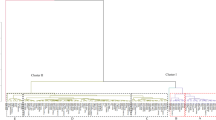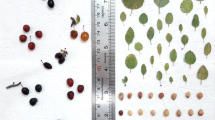Abstract
In this research, 53 male fig (caprifig) accessions were analyzed for phenotypic diversity using 32 morphological variables. Significant phenotypic diversity was detected between male fig accessions based on morphological traits. Principal component analysis revealed that the first ten components explained 76.09 % of the total morphological variation, where petiole length, petiole thickness, leaf length, leaf width, fruit width, fruit shape, length of central lobe, number of lobes and leaf shape contributed most of the total variation. Simple correlation coefficient analysis showed the existence of significant positive and negative correlations among characteristics. The majority of significant correlation coefficients were found in the characteristics representing fruit sizes with leaf size. Unweighted pair-group method of arithmetic average cluster analysis identified two major clusters and several subclusters for studied accessions. According to the present results, accessions Caprifig 35, Caprifig 6, Caprifig 12, Caprifig 36, Caprifig 38, Caprifig 28, Caprifig 30, Caprifig 26 and Caprifig 18 with the highest Blastophaga number are suitable in this important trait to be used for caprification. Also, the conservation of the highly diverse native accessions of Iranian male figs is recommended.



Similar content being viewed by others
References
Aljane F, Ferchichi A (2007) Characterization and evaluation of six cultivars of caprifig (Ficus carica L.) in Tunisia. Plant Genet Resour Newsl 151:22–26
Aljane F, Nahdi S, Essid A (2012) Genetic diversity of some accessions of Tunisian fig tree (Ficus carica L.) based in morphological and chemical traits. J Nat Prod Plant Resour 2:350–359
Almajalia D, Abdel-Ghanib AH, Migdadia H (2012) Evaluation of genetic diversity among Jordanian fig germplasm accessions by morphological traits and ISSR markers. Sci Hortic 147:8–19
Berg CC (1989) Classification and distribution of Ficus. Experientia 45:605–611
Caliskan O, Polat AA (2008) Fruit characteristics of fig cultivars and genotypes grown in Turkey. 2008. Sci Hortic 115:360–367
Caliskan O, Polat AA (2012) Morphological diversity among fig (Ficus carica L.) accessions sampled from the Eastern Mediterranean Region of Turkey. Turk J Agric For 36:179–193
Can HZ (1993) The investigation of some horticultural characteristics of some selected fig genotypes in Aegean Region. Master Thesis, Ege University, Izmir, Turkey (in Turkish, with English abstract)
Chalack L, Chehade A, Mattar E, Khadari B (2005) Morphological characterization of fig accessions cultivated in Lebanon. Acta Hortic 798:54–61
Condit IJ (1941) Fig characteristics useful in the identification of varieties. Hilgardia 14(1)
Condit IJ (1955) Fig varieties: a monograph. Hilgardia 23:323–538
Dicenta F, Garcia JE (1992) Phenotypical correlations among some traits in almond. J Genet Breed 46:241–246
Esquinas-Alcazar J (2005) Protecting crop genetic diversity for food security: political, ethical and technical challenges. Nat Rev Genet 6:946–953
Falistocco E, Antonielli L (2002) Molecular cytogenetics of Vitis vinifera L. and Ficus carica L.: location of rDNA sequences. In: Fippone E (ed) Proceedings of XLVI Italian society of agricultural genetics, SIGA annual Congress, Giardini, Italy
Flaishman MA, Yablovich Z, Golobovich S, Salamon A, Cohen Y, Perl A, Yancheva SD, Kerem Z, Haklay E (2008) Molecular breeding in fig (Ficus carica) by the use of genetic transformation. Acta Hortic 798:151–158
Gaaliche B, Saddoud O, Mars M (2012) Morphological and pomological diversity of fig (Ficus carica L.) cultivars in northwest of Tunisia. ISRN Agronomy. doi:10.5402/2012/326461
Giraldo E, Lopez-Corrales M, Hormaza JI (2008a) Optimization of the management of an ex-situ germplasm bank in common fig with SSRs. J Am Soc Hortic Sci 133:69–77
Giraldo E, Lopez-Corrales M, Hormaza JI (2008b) Selection of morphological quantitative variables in fig characterization. Acta Hortic 798:103–108
Giraldo E, Lopez Corrales M, Hormaza JI (2010) Selection of the most discriminating morphological qualitative variables for characterization of fi g germplasm. J Am Soc Hortic Sci 135:240–249
Hammer Ø, Harper DAT, Ryan PD (2001) PAST: paleontological statistics software package for education and data analysis. Palaeontologia Electronica 4(1):9. http://palaeoelectronica.org/2001_1/past/issue1_01.htm
Hedfi J, Trifi M, Salhi-Hannachi A, Ould Mohamed Salem A, Marrakchi M (2003) Morphological and isoenzymatic polymorphism in Tunisian fig (Ficus carica L.) collection. Acta Hortic 605:319–325
Iezzoni AF, Pritts MP (1991) Applications of principal components analysis to horticultural research. HortScience 26:334–338
Ilgin M (1995) The investigation of fertilization biology of some fig genotypes selected from Kahramanmaras¸ region. PhD Thesis, Cukurova University, Adana, Turkey (in Turkish, with English abstract)
IPGRI and CIHEAM (2003) Descriptors for Figs. International Plant Genetic Resources Institute (IPGRI), Rome, Italy, and the International Centre for Advanced Mediterranean Agronomic Studies (CIHEAM), Paris, France
Machado CA, Jousselin E, Kjellberg F, Compton SG, Herre EA (2001) Phylogenetic relationships, historical biogeography and character evolution of fig pollinating wasps. Proc R Soc Lond B Biol 268:7–10
Mahdavian M, Lessani H, Kuhi M, Zare H, Krami M, Tabatabei Z (2006) Assessment of genetic diversity among different fig (Ficus carica L.) collection from Iran. Acta Hortic 760:29–37
Mars M (2003) Fig (Ficus carica L.) genetic resources and breeding. Acta Hortic 605:19–27
Mars M, Chebli T, Marrakchi M (1998) Multivariate analysis of fig (Ficus carica L.) germplasm in southern Tunisia. Acta Hortic 480:75–81
Mohammadi SA, Prasanna BM (2003) Analysis of genetic diversity in crop plants—salient statistical tools and considerations. Crop Sci 43:1235–1248
Norman PE, Tongoona P, Shanahan PE (2011) Determination of interrelationships among agr-morphological traits of yams (Discorea spp.) using correrlation and factor analyses. J Appl Biosci 45:3059–3070
Okut H, Akca Y (1995) Study to determine the causal relations between fruit weight and certain important fruit characteristics with using a path analysis. Acta Hortic 384:97–102
Oukabli A, Mamouni A, Laghezali R, Khadari B, Roger JP, Kjellberg F, Ater M (2002) Genetic variability in Morrocan fig cultivars (Ficus carica) based on morpholigical and pomological data. Acta Hortic 605:54–60
Papadopoulou K, Ehaliotis C, Tourna M, Kastani P, Karydis I, Zervakis G (2002) Genetic relatedness among diocious Ficus carica L. cultivars by random amplified polymorphic DNA analysis, and evaluation of agronomic and morphological characters. Genetica 114:183–194
Polat AA, Ozkaya M (2005) Selection studies on fig in the Mediterranean region of Turkey. Pak J Bot 37(3):567–574
Rohlf FJ (2000) NTSYS-pc numerical taxonomy and multivariate analysis system. Version 2. 1. Exeter Software, Setauket, NY
Saddoud O, Baraket G, Chatti K (2008) Morphological variability of fig (Ficus carica L.) cultivars. Int J Fruit Sci 8(1–2):35–51
Saddoud O, Baraket G, Chatti K (2011) Using morphological characters and simple sequence repeat (SSR) Markers to characterize Tunisian fig (Ficus carica L.) cultivars. Acta Biologica Cracoviensia 53(2):7–14
Salhi-Hannachi A, Mars M, Chatti K, Marrakchi M, Trifi M (2003) Specific genetic markers for Tunisian fig germplasm: evidence of morphological traits, random amplified polymorphic DNA and inter simple sequence repeats markers. J Genet Breed 57(2):125–136
Sanches J, Melgarejo P, Hemandz F, Martienz JJ (2002) Chemical and morphological characterization of four fig tree cultivars (Ficus carica L.) grown under similar culture conditions. Acta Hortic 605:33–36
Stover E, Aradhya M (2008) Fig genetic resources and research at the US National Clonal Germplasm Repository in Davis, California. Acta Hortic 798:57–68
Taiz L, Zeiger E (2002) Plant physiology, 3rd edn. Sinauer Associates, Sunderland
Zeybekoglu NS, Mısırlı A, Gülcan R (1998) Researches on pollen germination ability of some caprifig varieties. Acta Hortic 480:125–128
Author information
Authors and Affiliations
Corresponding author
Rights and permissions
About this article
Cite this article
Khadivi-Khub, A., Anjam, K. Characterization and evaluation of male fig (caprifig) accessions in Iran. Plant Syst Evol 300, 2177–2189 (2014). https://doi.org/10.1007/s00606-014-1038-4
Received:
Accepted:
Published:
Issue Date:
DOI: https://doi.org/10.1007/s00606-014-1038-4




